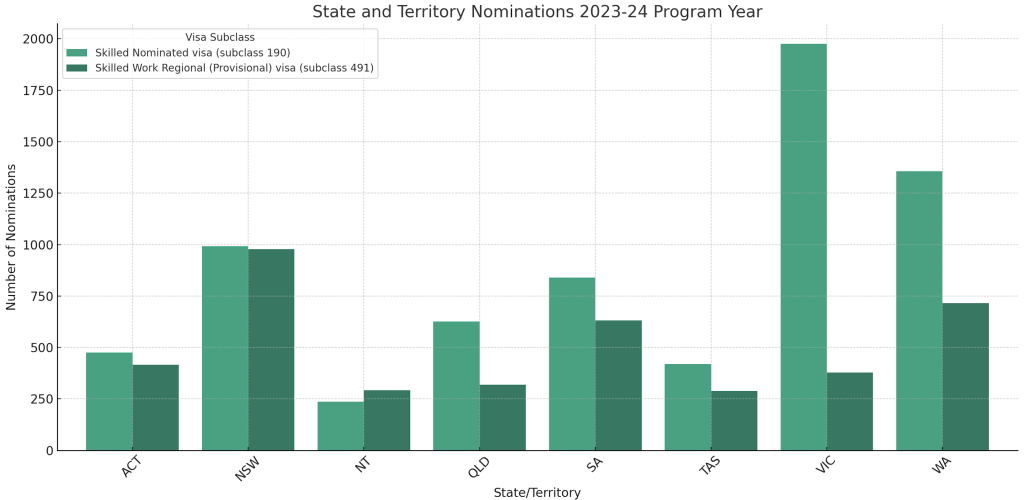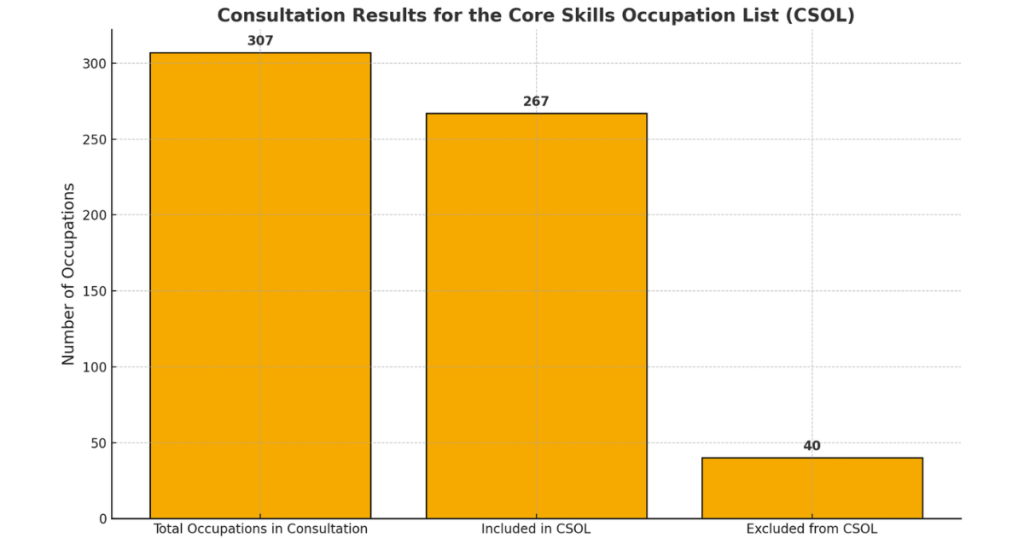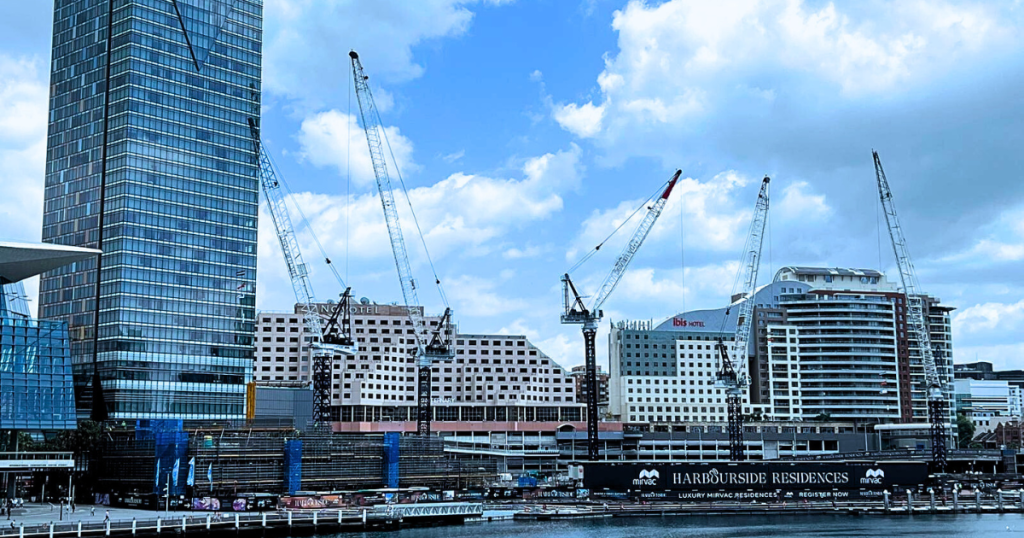The Ultimate Guide to Skilled Migration in Australia (2024 Update)
-
Agriculture
-
All Agriculture
Select sub classifications-
Agricultural Technician
-
Fisheries Officer
-
Meat Inspector
-
Quarantine Officer
-
Primary Products Inspector Nec
-
Aquaculture Farmer
-
Cotton Grower
-
Flower Grower
-
Fruit or Nut Grower
-
Grain, Oilseed or Pasture Grower
-
Grape Grower
-
Mixed Crop Farmer
-
Sugar Cane Grower
-
Turf Grower
-
Vegetable Grower
-
Crop Farmers nec
-
Apiarist
-
Beef Cattle Farmer
-
Dairy Cattle Farmer
-
Deer Farmer
-
Goat Farmer
-
Horse Breeder
-
Mixed Livestock Farmer
-
Pig Farmer
-
Poultry Farmer
-
Sheep Farmer
-
Livestock Farmer nec
-
Mixed Crop and Livestock Farmer
-
Hunter Trapper
-
Pest Controller
-
Farm, Forestry and Garden Workers Nec
-
Wine Maker
-
Food Technologist
-
Agricultural Engineer
-
Agriculture Consultant
-
Forester
-
Biomedical Engineer
-
Production Manager (Forestry)
-
Shearer
-
Veterinary Nurse
-
Wool Buyer
-
Florist
-
Gardener (General)
-
Arborist
-
Landscape Gardener
-
Greenkeeper
-
Nurseryperson
-
Dog Trainer or Handler
-
Horse Trainer
-
Pet Groomer
-
Zookeeper
-
Animal Attendants and Trainers (nec)
-
Agricultural and Horticultural Mobile Plant Operator
-
Logging Plant Operator
-
Conservation Officer
-
Environmental Consultant
-
Environmental Research Scientist
-
Park Ranger
-
Environmental Scientists (nec)
-
Automotive Heavy Mechanic (Agricultural)
-
-
Automotive
-
All Automotive
Select sub classifications-
Automotive Electrician
-
Motor Vehicle Parts and Accessories Fitter
-
Motor Vehicle or Caravan Salesperson
-
Panelbeater
-
Motor Vehicle Parts Interpreter
-
Vehicle Body Builder
-
Vehicle Trimmer
-
Vehicle Painter
-
Motor Mechanic (General)
-
Diesel Motor Mechanic
-
Motorcycle Mechanic
-
Small Engine Mechanic
-
Workshop/Service Centre Manager
-
Workshop Manager/Leading Hand
-
Fleet Manager
-
Railway Station Manager
-
Transport Company Manager
-
Others
-
-
Engineering
-
All Engineering
Select sub classifications-
Engineering Manager
-
Chemical Engineer
-
Materials Engineer
-
Civil Engineer
-
Geotechnical Engineer
-
Quantity Surveyor
-
Structural Engineer
-
Transport Engineer
-
Electrical Engineer
-
Electronics Engineer
-
Industrial Engineer
-
Mechanical Engineer
-
Production or Plant Engineer
-
Mining Engineer (excluding Petroleum)
-
Petroleum engineer
-
Aeronautical Engineer
-
Agricultural Engineer
-
Biomedical Engineer
-
Engineering Technologist
-
Environmental Engineer
-
Naval Architect
-
Engineering Professionals (nec)
-
Telecommunications Engineer
-
Telecommunications Network Engineer
-
Civil Engineering Technician
-
Civil Engineering Draftsperson
-
Electrical Engineering Technician
-
Electrical Engineering Draftsperson
-
Electronic Engineering Technician
-
Electronic Engineering Draftsperson
-
Mechanical Engineering Technician
-
Mechanical Engineering Draftsperson
-
Telecommunications Field Engineer
-
Telecommunications Network Planner
-
Telecommunications Technical Officer or Technologist
-
Architectural Draftsperson
-
Building Associate
-
Building Inspector
-
Construction Estimator
-
Plumbing Inspector
-
Surveying or Spatial Science Technician
-
Architectural, Building & Surveying Technicians (nec)
-
Safety Inspector
-
Maintenance Planner
-
Metallurgical or Materials Technician
-
Mine Deputy
-
Building and Engineering Technicians nec
-
Aeroplane Pilot
-
Air Traffic Controller
-
Flying Instructor
-
Helicopter Pilot
-
Air Transport Professionals nec
-
Master Fisher
-
Ship's Engineer
-
Ship's Master
-
Ship's Officer
-
Ship's Surveyor
-
Marine Transport Professionals nec
-
Architect
-
Landscape Architect
-
Surveyor
-
Cartographer
-
Other Spatial Scientist
-
Industrial Designer
-
Urban and Regional Planner
-
Software Engineer
-
Computer Network & Systems Engineer
-
ICT Quality Assurance Engineer
-
ICT Support Engineer
-
ICT Systems Test Engineer
-
ICT Support and Test Engineers (nec)
-
Aircraft Maintenance Engineer (Avionics)
-
Aircraft Maintenance Engineer (Mechanical)
-
Aircraft Maintenance Engineer (Structures)
-
Others
-
-
Healthcare & Medical
-
All Healthcare & Medical
Select sub classifications-
Registered Nurse (Aged Care)
-
Registered Nurse (Child & Family Health)
-
Registered Nurse (Community Health)
-
Registered Nurse (Critical Care & Emergency)
-
Registered Nurse (Developmental Disability)
-
Registered Nurse (Disability & Rehabilitation)
-
Registered Nurse (Medical)
-
Registered Nurse (Medical Practice)
-
Registered Nurse (Mental Health)
-
Registered Nurse (Perioperative)
-
Registered Nurse (Surgical)
-
Registered Nurse (Paediatrics)
-
Registered Nurses (nec)
-
MIDWIFE
-
Nurse Practitioner
-
General Practitioner
-
Resident Medical Officer
-
Anaesthetist
-
Specialist Physician (General Medicine)
-
Cardiologist
-
Clinical Haematologist
-
Medical Oncologist
-
Endocrinologist
-
Gastroenterologist
-
Intensive Care Specialist
-
Neurologist
-
Paediatrician
-
Renal Medicine Specialist
-
Rheumatologist
-
Thoracic Medicine Specialist
-
Specialist Physicians nec
-
Psychiatrist
-
Surgeon (General)
-
Cardiothoracic Surgeon
-
Neurosurgeon
-
Orthopaedic Surgeon
-
Otorhinolaryngologist
-
Paediatric Surgeon
-
Plastic and Reconstructive Surgeon
-
Urologist
-
Vascular Surgeon
-
Dermatologist
-
Emergency Medicine Specialist
-
Obstetrician and Gynaecologist
-
Ophthalmologist
-
Pathologist
-
Diagnostic and Interventional Radiologist
-
Radiation Oncologist
-
Medical Practitioners nec
-
Medical Diagnostic Radiographer
-
Medical Radiation Therapist
-
Nuclear Medicine Technologist
-
Sonographer
-
Optometrist
-
ORTHOPTIST
-
Dietitians
-
Environmental Health Officer
-
Occupational Health and Safety Adviser
-
Hospital Pharmacist
-
Industrial Pharmacist
-
Retail Pharmacist
-
Health Promotion Officer
-
Orthotist or Prosthetist
-
Health Diagnostic and Promotion Professionals nec
-
Chiropractors
-
Osteopaths
-
Acupuncturist
-
Homeopath
-
Naturopath
-
Traditional Chinese Medicine Practitioner
-
Complementary Health Therapist nec
-
Dental Specialist
-
Dentist
-
Occupational Therapist
-
Physiotherapist
-
Podiatrist
-
Audiologist
-
Speech Pathologist
-
Nurse Educator
-
Nurse Researcher
-
Nurse Manager
-
Medical Administrator
-
Nursing Clinical Director
-
Primary Health Organisation Manager
-
Welfare Centre Manager
-
Health And Welfare Services Managers (nec)
-
Enrolled Nurse
-
Mothercraft Nurse
-
Ambulance Officer
-
Intensive Care Ambulance Paramedic
-
Dental Hygienist
-
Dental Prosthetist
-
Dental Technician
-
Dental Therapist
-
Diversional Therapist
-
Aboriginal and Torres Strait Island Health Worker
-
Massage Therapist
-
Community Worker
-
Disabilities Services Officer
-
Family Support Worker
-
Parole or Probation Officer
-
Residential Care Officer
-
Youth Worker
-
Anaesthetic Technician
-
Cardiac Technician
-
Medical Laboratory Technician
-
Operating Theatre Technician
-
PHARMACY TECHNICIAN
-
Pathology Collector
-
Medical Technicians (nec)
-
Other
-
-
IT
-
All IT
Select sub classifications-
Chief Information Officer
-
ICT Project Manager***
-
ICT Managers (nec)
-
ICT Trainer
-
ICT Business Analyst
-
Systems Analyst
-
Multimedia Specialist
-
Web Developer***
-
Analyst Programmer
-
Developer / Programmer
-
Software Engineer
-
Software Tester
-
Software & Applications Programmers (nec)
-
Database Administrator
-
ICT Security Specialist
-
Systems Administrator
-
Computer Network & Systems Engineer
-
Network Administrator
-
Network Analyst
-
ICT Quality Assurance Engineer
-
ICT Support Engineer
-
ICT Systems Test Engineer
-
ICT Support and Test Engineers (nec)
-
Web Administrator
-
ICT Account Manager
-
ICT Business Development Manager
-
ICT Sales Representative
-
Multimedia Designer
-
Graphic Designer
-
Illustrator
-
Web Designer
-
Other
-
-
Scientific
-
All Scientific
Select sub classifications-
Conservation Officer
-
Environmental Consultant
-
Environmental Research Scientist
-
Park Ranger
-
Environmental Scientists (nec)
-
Anatomist or Physiologist
-
Biochemist
-
Biotechnologist
-
Botanist
-
Marine Biologist
-
Microbiologist
-
Zoologist
-
Life scientists (nec)
-
Life scientist (General)
-
Chemistry Technician
-
Earth Science Technician
-
Life Science Technician
-
School Laboratory Technician
-
Science Technicians (nec)
-
Medical Laboratory Scientist
-
Chemist
-
Food Technologist
-
Wine Maker
-
Geologist
-
Geophysicist
-
Agriculture Scientist
-
Chemical Engineer
-
Laboratory Manager
-
Natural and Physical Science Professionals nec
-
Nutritionist
-
Pathology Collector
-
Quality Assurance Manager
-
Sales Representative - Medical and Pharmaceutical
-
Veterinarian
-
Others
-
Hospital Pharmacist
-
Industrial Pharmacist
-
Retail Pharmacist
-
-
Trade
-
All Trade
Select sub classifications-
Airconditioning and Mechanical Services Plumber
-
Airconditioning and Refrigeration Mechanic
-
Aircraft Maintenance Engineer (Avionics)
-
Aircraft Maintenance Engineer (Mechanical)
-
Aircraft Maintenance Engineer (Structures)
-
Apparel Cutter
-
Baker
-
Pastrycook
-
Blacksmith
-
Boat Builder and Repairer
-
Bricklayer
-
Broadcast Transmitter Operator
-
Business Machine Mechanic
-
Butchers and Smallgoods Maker
-
Cabinetmaker
-
Cabler (Data and Telecommunications)
-
Camera Operator (Film, Television or Video)
-
Canvas Goods Fabricator
-
Carpenter
-
Carpenter and Joiner
-
Chef
-
Chemical Plant Operator
-
Clothing Trades Worker (nec)
-
Clothing Patternmaker
-
Communications Operator
-
Cook
-
Drainer
-
Dressmaker or Tailor
-
Electrical Linesworker
-
Electrician (General)
-
Electrician (Special Class)
-
Electronic Equipment Trades Worker
-
Electronic Instrument Trades Worker (General)
-
Electronic Instrument Trades Worker (Special Class)
-
Electroplater
-
Engineering Patternmaker
-
Engraver
-
Farrier
-
Fibrous Plasterer
-
Fire Protection Equipment Technician
-
Fitter (General)
-
Fitter and Turner
-
Fitter-Welder
-
Floor Finisher
-
Furniture Finisher
-
Gallery or Museum Technician
-
Gas or Petroleum Operator
-
Gasfitter
-
Glazier
-
Graphic Pre-press Trades Worker
-
Gunsmith
-
Hairdresser
-
Jeweller
-
Joiner
-
Leather Goods Maker
-
Lift Mechanic
-
Light Technician
-
Locksmith
-
Make up Artist
-
Metal Casting Trades Worker
-
Metal Fabricator
-
Metal Fitters and Machinists nec
-
Metal Machinist (First Class)
-
Metal Polisher
-
Musical Instrument Maker or Repairer
-
Optical Dispenser
-
Optical Mechanic
-
Painting Trades Workers
-
Pastry cook
-
Performing Arts Technician (nec)
-
Picture Framer
-
Plastics Technician
-
Plumber (General)
-
Power Generation Plant Operator
-
Precision Instrument Maker and Repairer
-
Pressure Welder
-
Print Finisher
-
Printing Machinist
-
Roof Plumber
-
Roof Tiler
-
Sail Maker
-
Saw Maker and Repairer
-
Screen Printer
-
Sheetmetal Trades Worker
-
Shipwright
-
Shoemaker
-
Signwriter
-
Small Offset Printer
-
Solid Plasterer
-
Sound Technician
-
Stonemason
-
Technical Cable Jointer
-
Technicians and Trades Workers nec
-
Telecommunications Cable Jointer
-
Telecommunications Linesworker
-
Telecommunications Technician
-
Television Equipment Operator
-
Textile, Clothing and Footwear Mechanic
-
Toolmaker
-
Upholsterer
-
Wall and Floor Tiler
-
Watch and Clock Maker and Repairer
-
Welder (First Class)
-
Wood Machinist
-
Wood Machinists and Other Wood Trades Workers nec
-
Wood Turner
-
Fashion Designer
-
Jewellery Designer
-
Interior Designer
-
Other
-
REFINE RESULTS
The Ultimate Guide to Skilled Migration in Australia (2024 Update)
.png)
Australia remains one of the top destinations for skilled workers worldwide, offering incredible opportunities in a wide range of industries. If you’re a skilled worker looking to migrate to Australia or an employer seeking to sponsor skilled talent, this guide is for you. In 2024, Australia introduced several key updates to its skilled migration pathways, visa requirements, and application processes, making it essential to stay informed.
In this guide, we will walk you through everything you need to know about skilled migration to Australia in 2024, including visa types, eligibility criteria, the application process, and recent changes to the program.
Why Australia?
Australia offers a high standard of living, competitive salaries, and the chance to work in diverse sectors such as IT, healthcare, engineering, and trades. The Australian government is actively seeking skilled workers to fill critical skill shortages, making now the perfect time to explore migration options.
2024 Skilled Migration Pathways
There are several pathways to skilled migration in Australia, each catering to different professions, skill levels, and personal circumstances. Here are the main visa options for skilled workers in 2024:
-
Skilled Independent Visa (subclass 189):
This visa is ideal for highly skilled workers who do not require sponsorship from an employer or family member. You can live and work anywhere in Australia.
- Eligibility: Must be invited to apply after submitting an Expression of Interest (EOI). Points-based system, where factors such as age, work experience, and English proficiency are considered.
- Visa Duration: Permanent Residency.
-
Skilled Nominated Visa (subclass 190):
This visa requires a nomination from an Australian state or territory government.
- Eligibility: Must be nominated by a state or territory. Points-based system.
- Visa Duration: Permanent Residency.
-
Skilled Work Regional (Provisional) Visa (subclass 491):
Designed for skilled workers willing to live and work in regional Australia, this visa encourages skilled migration to less populated areas.
- Eligibility: Requires either state nomination or sponsorship by an eligible family member living in a regional area.
- Visa Duration: 5 years, with a pathway to permanent residency (subclass 191).
-
Employer Nomination Scheme (subclass 186):
This visa allows Australian employers to sponsor skilled workers for permanent residency.
- Eligibility: Requires a job offer from an approved Australian employer.
- Visa Duration: Permanent Residency.
How to Apply for Skilled Migration in Australia
The process of applying for skilled migration involves several key steps, and it’s important to follow them carefully to ensure success.
Step 1: Check Your Occupation
The first step is to verify if your occupation is listed on the relevant Skilled Occupation List (SOL). There are three main occupation lists in 2024:
- Medium and Long-term Strategic Skills List (MLTSSL)
- Short-term Skilled Occupation List (STSOL)
- Regional Occupation List (ROL)
Step 2: Points-Based System
Australia’s skilled migration visas operate on a points-based system. Points are awarded for factors such as age, qualifications, work experience, English proficiency, and whether you have been nominated by a state or territory. The higher the points, the higher the chance of receiving an invitation.
- Age: Maximum points are awarded to those aged 25–32.
- English Proficiency: The higher your score in recognized English tests (e.g., IELTS), the more points you earn.
- Work Experience: Points increase with more years of skilled work experience.
-
Education: Holding a recognized qualification, particularly one obtained in Australia, earns extra points
Skills Assessment: A skills Assessment may also be required.
Step 3: Submit an Expression of Interest (EOI)
Once you’ve calculated your points and are confident you meet the threshold (currently 65 points), submit an Expression of Interest (EOI) through SkillSelect, an online system used by the Australian government to manage migration applications.
Step 4: Receive an Invitation to Apply
If your EOI is successful, you will receive an invitation to apply for a visa. You have 60 days to submit a complete application, including supporting documents like skills assessments, health checks, and police clearances.
Step 5: Lodge Your Visa Application
Submit your visa application online through the Department of Home Affairs website. Ensure that you have all the required documents, as incomplete applications may result in delays or rejection. Ensure that you have not lost any points.
Visa Requirements for Skilled Workers in 2024
For most skilled migration visas, you will need to meet the following general requirements:
- Skills Assessment: Obtain a positive skills assessment from the relevant authority for your occupation.
- English Language Proficiency: You must meet the English language requirement, typically through an IELTS or PTE score.
- Health and Character Requirements: Applicants must undergo a medical examination and provide police clearance certificates.
- Points Test: As previously mentioned, most skilled visas require you to pass the points test, with a minimum score of 65 points.
What’s New for 2024?
- Increased Occupation List: The Australian government has expanded the list of eligible occupations for skilled migration to meet labor market demands in sectors like healthcare, construction, and technology.
- Regional Incentives: Visa applicants willing to work in regional areas can benefit from increased points, quicker processing times, and additional permanent residency options.
- Streamlined Pathways for Critical Sectors: Skilled migrants in sectors like healthcare and information technology may benefit from faster processing times and priority approval in 2024.
Common Mistakes to Avoid
- Incorrect EOI Information: Ensure all the information in your EOI is accurate and up to date.
- Missing Documents: Double-check your visa application for completeness.
- Ignoring the English Requirement: Make sure your English test results meet the visa requirement before lodging your application.
How Employers Can Sponsor Skilled Workers
Australian employers can sponsor overseas workers through the Employer Nomination Scheme (subclass 186) or the Temporary Skill Shortage Visa (subclass 482). The key steps for employers include:
- Become an approved sponsor.
- Nominate a position that meets visa criteria.
- Sponsor the worker for either temporary or permanent residency.
For more details, check our blog on sponsoring skilled workers in Australia!
Related News
Analysing Australia’s State and Territory Nominations for the 2023-24 Program Year
Key Highlights from the Current Program Year The latest data highlights significant activities across various visa subclasses, particularly the Skilled Nominated visa (subclass 190), the Skilled Work Regional (Provisional) visa (subclass 491) State and Territory Nominated, the Business Innovation and Investment (provisional) visa (subclass 188), and notably, the Skilled Independent visa (subclass 189). While there…
Changes to the TSS Visa Program: Introducing the Skills in Demand Visa
Changes to the TSS Visa Program: Introducing the Skills in Demand Visa We have been waiting for months for the new Skills in Demand Visa, and when the bill to introduce the visa was delayed in the Senate, we assumed it would not be introduced until at least February 2025, and even then with an…
Top Construction Trade Occupations Now Prioritised for Skilled Visas in Victoria
Top Construction Trade Occupations Now Prioritised for Skilled Visas in Victoria Are you a skilled tradesperson looking to work and live in Australia? The Victorian Government has unveiled an exciting opportunity for professionals in construction trades. As part of the 2024-25 Skilled Visa Nomination Program, key construction occupations are being prioritised to fill critical shortages…




